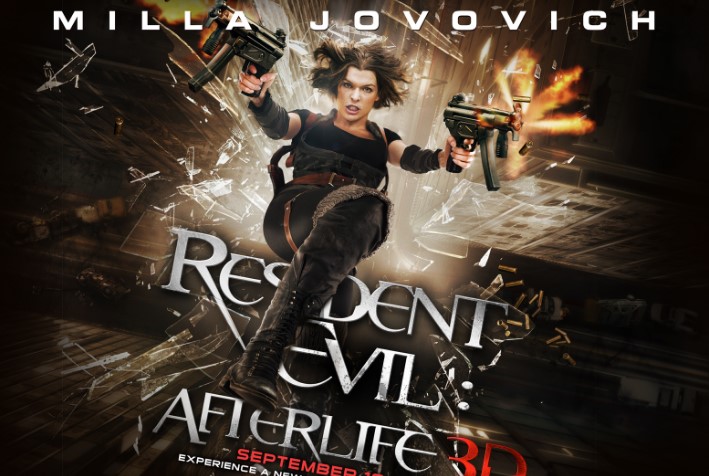
When the fetus is born, its placenta begins a physiological separation for spontaneous expulsion afterwards and for this reason is also called afterbirth. The Resident Evil movie franchise (in relation to the video game mythos) can be described as such. The one person responsible for all this is Paul W.S. Anderson and he has committed bloody murder to one of my favorite, ever-evolving, video game storylines. I do not like what he has done, I do not like what he is doing and I shutter to think about what he is going to do. Please reference my article concerning the state of Hollywood in regards to Anderson, but in summary: if anyone believes this man has an ounce of genuine creativity in his body, I recommend a cat scan and a colonoscopy.
Apologies, but it is necessary for the reader to fully understand where I am coming from in regards to anything hatched by Anderson and thus we move on.
Resident Evil: Afterlife had some spectacularly low expectations and negative sentiment from yours truly. However, I must admit that it was an improvement in regards to its production value, effects, action, music and cinematography. Of course, with a budget of $60 million one expects a significant upgrade in the overall look of a film franchise that began with a mere $32 million. One can definitely notice the budgetary bump in the sleeker designs for just about every interior location. Another significant upgrade is the intensity of the musical soundtrack to Afterlife which features more techno, more bass, and more heart-throbbing drone. The last time anyone mentioned anything relevant concerning the music of Resident Evil was back when the first film rolled out and Anderson somehow tapped Marilyn Manson to create the original score which has since become the film franchise’s theme featuring derivative remixes for the consequent sequels. Tom Hajdu and Andy Milburn of “tomandandy” music productions offer a major upgrade in this department. The overall quality of their tracks lent significant credibility to scenes that would have been noteworthy for being awkwardly long and unnecessary without them. In some instances, such as the introductory shots of the movie taking place in Japan, featuring the mesmerizing effect of the music was the only justification for having any of the shots at all.
The highly improved visual style for this film was absolutely necessary to compliment an equally improved slate of action sequences and special effects. In the previous films, the action seemed a little out of place because it tried to establish the Alice character (Jovovich) as some kung-fu master wizard. Afterlife thankfully features gunplay and other weapon based activity to satisfying results in both the beginning and ending of the film. I wish there was more action featured in the middle of the film which was inundated with dialogue and exposition, but the very strong climactic battle with the main antagonist, Wesker, does much to allow the audience to forget such shortcomings.
While the action was amped up, the digital effects were cleaned up and the best example of this was the self-destruct detonation explosion of the “Umbrella Facility Purge.” The scale of this effect is pure eye candy for the audience and massive enough to be on par with standard issue Skywalker Ranch quality, so I give much respect to the production staff of Paul Jones FX Studios for their work. Another area of the improved special effects was the presence of the Alice clones which is hinted at the end of Resident Evil: Extinction. Although the film trailers make the clones look like a dressed up version of a cut and paste experiment, they are displayed in the film with much greater appeal. Unfortunately, the clones are dealt with far too soon so as to placate to massive deficiencies in plot in order to advance the story and we are simply left with the original Alice and uninspired wire work to hold us over until the third act.
In regards to the use of 3-D technology, let me say that this film’s use does not exceed a token and gimmicky effort so as to maximize profitability on a per ticket basis. The fact remains that this film had an amazing opening weekend exceeding $26 million, but has since grossed a shade over $52 million. IMAX Digital 3-D is a wonderful way to experience cinema, but it is not worth double the price of a regular admission. In my opinion, the only film that warrants this kind of expense is when the content and context of the film demand the audience’s assimilation into the screen as much as possible. This is one of the main reasons why Avatar was the financial boom it turned out to be. The story was definitely ripped from several historic and fictional examples of the white man’s burden, but it was also about entering another reality within the framework of a fictional tale. This kind of story truly resonates with all kinds of people because we may all experience reality with different opinions and backgrounds, but the mechanics of which like the first person perspective of sight and sound is the same. When James Cameron saw The Matrix, I’ll bet he said to himself: “I can do that, but then take it a step further!” Thus, Avatar was born.
The performances of the cast do not exceed any level of intimacy as established in any of the previous Resident Evil films. In fact, if I had to select the most poignant moment of real emotion, I’d have to go way back to the scraps of screen time given to Eric Mabius in the first film, especially the moment when he talks about his sister’s role with Umbrella to Alice. This is where Anderson forces Resident Evil to adopt standard action film protocol to simply move on to the next dialogue, action or effect sequence to feature the spectacle over any perceived substance. And that is a real shame because at the very heart of the story, Resident Evil (like all zombie apocalypse films) is a story about humanity’s survival and what could be more emotional than that?
Despite that, Milla Jovovich mails in another nominally adequate performance as Alice despite the fact that her character really has not changed in the four years that have passed since the Raccoon City incident. It’s not like the plot fails to deliver a moment where she can produce an emotional home run either. As Alice continues to look for survivors she gives a number of camcorder confessionals outlining her progress and Jovovich does not convey the depth of despair someone in Alice’s situation ought to be feeling. Perhaps it’s because Americans have been soured on reality TV’s contrived confessional format that we automatically shrug a moment like this off, but when it’s just you, a camera and a world of destruction, I know this is a moment where the window of true humanity can be opened. The big disappointment for Jovovich’s performance is that she fails to deliver some kind of character arc or any kind of growth for that matter. Rest assured, she is every bit the bad a– she was in the first film and as comforting as it is to a franchise to have that kind of reliability, it displays a failure to take risks and promotes complacency.
Ali Larter, as accomplished as she is, continues to fill the role of sexy eye candy as Claire Redfield. Wentworth Miller as the much anticipated debut of the Chris Redfield character is disappointing less so for his own personal effort and more so as fulfilling another static role of a flat supporting character as dictated by the script. The only other noteworthy performance was Shawn Roberts as Albert Wesker who absolutely NAILS the character that is established in both the Code Veronica and Resident Evil 5 video games. Roberts masters the Wesker accent, the depraved brutality and his unforgiving demeanor. I was hoping for a moment where Wesker is allowed to fully unleash his rage, but was disappointed because that moment never came. My guess is that it will come in the following sequel.
Finally I have my favorite part of the review: the criticism of the script/story/plot. Is it ironic that Paul W.S. Anderson is the sole credit for this category? Anyone who knows anything about the fiction established in the video game cannon will tell you that the story woven by Anderson has no connection whatsoever. In Anderson’s version, the entire world has been overtaken by the T-Virus in a matter of four years, whereas the video games have highlighted several isolated incidents around the globe with the potential of breaking out, but ultimately being contained. In the video games, no one single character is featured, thus opening the fiction to new characters with different motives and backgrounds. In Anderson’s version, everything revolves around Alice because Milla Jovovich is hot, she happens to be his wife, and the films would not be green lit unless she was attached as the main character. Suffice it to say that as much as Anderson makes his films look, sound and feel like Resident Evil, it is simply NOT Resident Evil. This is the number one deficiency of the plot.
The second deficiency is the half hearted effort to make any connection at all to the video games. The best example of this in Afterlife is the appearance of the Axe Man who is an iconic antagonist of Resident Evil 5. In the film, the Axe Man simply shows up out of nowhere. Yep, that’s the beginning and end of the explanation. The Majini (zombies that open their jaw bones to feast) also show up without explanation or relevance to the story. These are the types of things that Anderson writes into the script simply because they made appearances in the video games and not because they have any significance to his own story. In fact, had the Majini and Axe Man been removed entirely, the story would not have been impacted in any way, save for a shorter run time and that my friends is an example of poor writing. Why have something in your story when it has nothing to do with anything?
The third deficiency is the lack of character development outside of the Alice character and even over the course of four films now, the audience cannot find a valid reason for that character to endure. Alice is about as flat of an action heroine as can be conceived and her ability to relate with an audience is ever decreasing. Other than her good looks, an ability to kick a– and save her friends from sticky situations, there’s nothing to like about her character. Now at first one may say, “Look she’s an action film character, what else does one need?” And that would be true for a one shot film, but this is a franchise that will more than likely see a fifth installment. Luke Skywalker does not fight the Empire because it exists, but because of revenge for Obi-Wan, love to protect his friends and family and eventually the higher ideals of what it truly means to be a Jedi and the morality required to maintain that standard. Alice fights Umbrella because it exists. At one point there were reasons similar to the Luke Skywalker example as established in the fiction of the first film, but those connections have faded because those characters are dead and Alice does not reconnect with new characters as she did when she wasn’t super-human. All other characters in Anderson’s stories are flat, fulfill very strict roles and never do anything that surprises an audience’s expectations.
All in all, this review comes off like a soap box rant that nit picks a flawed action film that should perhaps not be taken as seriously as I take it. I fully admit this and apologize for nothing because I want to give you, the audience, as much information as possible and prepare you for everything. Resident Evil: Afterlife is an entertaining film and the level of action is on par with The Expendables which is an improvement for a film franchise that has been fairly average in that area thus far. But at the end of the day, this film is defined by its conventionalism and poor writing, the two main culprits of what makes Hollywood films everything you expect them to be. This film is another example of what “the problem” is with Hollywood and is definitely not worth the price of an Imax Experience admission.
For more movie in-depth reviews by Lawrence Napoli check out the Cosmic Book News Movie Review Page!







